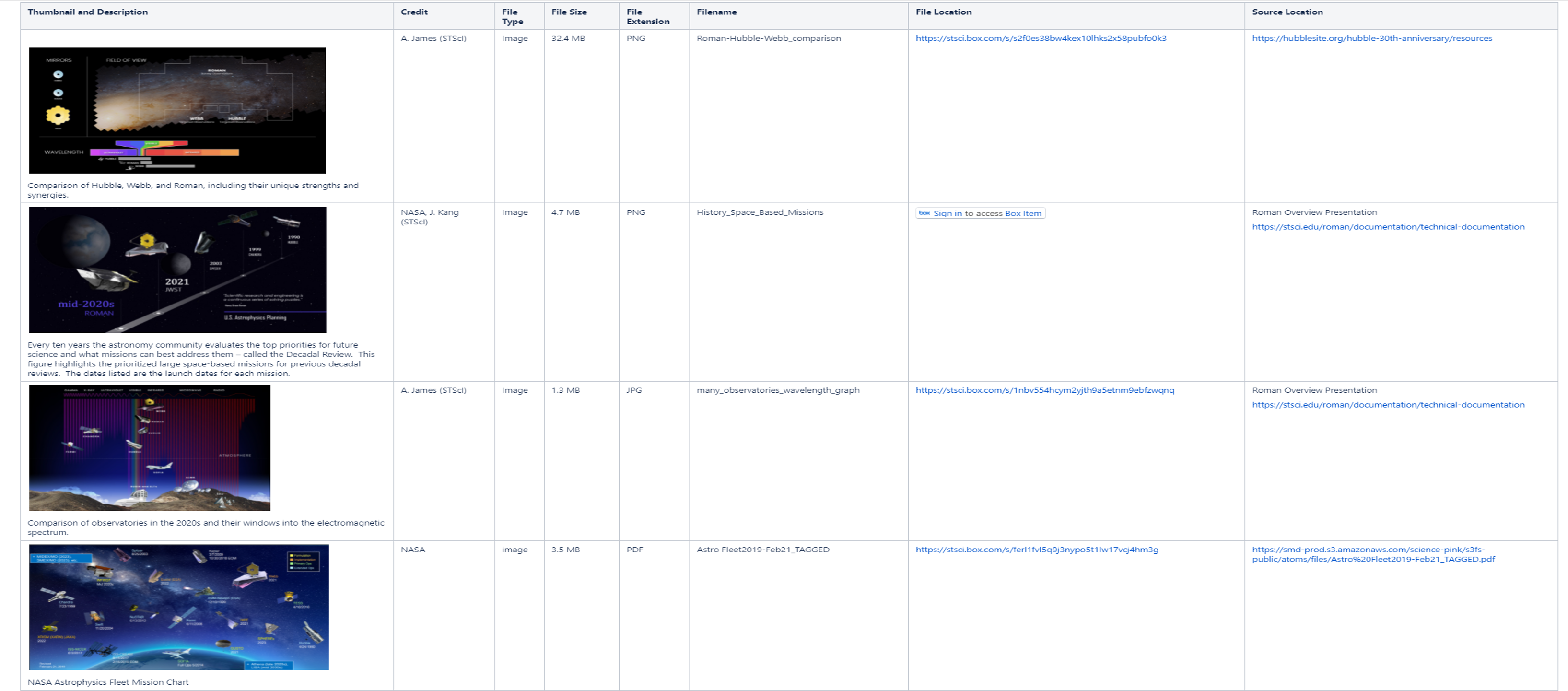Notice
If you are working on press-worthy science that relates to future Roman WFI science, we invite you to share your work with Brandon Lawton - lawton@stsci.edu - Project Scientist, Roman Science Communications. Brandon will be attending the meeting and at the STScI booth.
Brandon can work with the Roman partners to share your exciting science with the world!
Roman Events at the 241st AAS Meeting | ||
| Location | Title and Description | Date and Time (PT) |
|---|---|---|
Room 304 | Nearby Galaxies under a New Light with Roman | Monday, January 9, 2023 1:00 PM - 3:00 PM |
Room 4C-3 | Starting Now: Community-Led Definition of the Roman Core Community Surveys | Wednesday, January 11, 2023 2:00 PM - 3:30 PM |
Roman Resources Available at the 241st AAS Meeting |
Research and Support Participation Opportunities - Roman ROSES CallRESEARCH AND SUPPORT PARTICIPATION OPPORTUNITIES ROSES call in Apr 2022 (draft) solicits science and infrastructure teams to work on broad range of science preparatory efforts and develop infrastructure to pursue science goals. This solicitation represents a tripartite opportunity to provide for participation of the astrophysics community in the Roman mission through the categories of:
The NASA point of contact concerning this program is Dominic Benford, who will be attending this AAS meeting. |
Roman Science and Technical Overview BookletThis 36-page booklet provides a current overview of the scientific capabilities, technical specifications, and operations of the Nancy Grace Roman Space Telescope. It can also be found here. |
Roman Slide SetThis presentation highlights the science that will be enabled by the Nancy Grace Roman Space Telescope. The presentation includes notes for the presenter and can be used as a whole or in parts. The presentation comes in multiple formats, found here. We encourage scientists to take and use any or all of these slides, modified if needed, for your presentations about Roman science. |
Roman Visual LibraryThe Roman Visual Library, located here, is a resource for astronomers to grab Roman-related images. You can find images, captions, credits, and image source locations here. |
Roman BrochureTargeted for launch in late 2026, the Nancy Grace Roman Space Telescope will revolutionize astronomy by building on the science discoveries and technological leaps of the Hubble and Webb space telescopes. The Roman brochure, located here, provides a simple way to express the power of Roman's field of view and is useful for all audiences. |
Come and Find Us in the Exhibit Hall! |
How to Connect With Us |
|---|
NASA (Booth 702)
The Roman Space Telescope Project Office is at NASA's Goddard Space Flight Center, which also oversees the work on the Wide Field Instrument (WFI), the Spacecraft Bus, and System Integration.
Check out the NASA Hyperwall Talks
Come by the NASA booth to see Hyperwall presentations related to the Nancy Grace Roman Space Telescope and NASA's other missions.
STScI (Booth 715)
STScI is Roman’s Science Operations Center (SOC). The SOC is responsible for the mission's observation scheduling system, WFI data processing system for the direct-imaging mode and the mission's entire data archive. STScI performed pre-formulation, formulation, and design activities for Roman starting in 2014, and continues its role in science operations system engineering, design, science research support, and scientific community engagement and public outreach.
Contact us with questions
The Roman Help Desk is operated joinly by the SOC and the SSC. Contact the SOC helpdesk for questions about SOC tools, WFI imaging, data calibration and archiving, proposal planning and scheduling.
Caltech/IPAC (Booth 615)
IPAC is home to the Roman Science Support Center. IPAC is responsible for Roman’s Coronagraph Instrument operations, high-level data processing of grism and prism data from the Wide Field Instrument (WFI), high-level data processing of WFI microlensing survey data and community engagement for Roman exoplanet science and wide field spectroscopy. IPAC will also implement the proposal solicitation and grant management for the General Observer, Guest Investigator and Theory programs, curate telescope instrument and simulation efforts and engage the greater scientific community in preparing for science with Roman.
Contact us with questions
The Roman Help Desk is operated joinly by the SOC and the SSC. Contact the SSC helpdesk for questions about WFI spectroscopy, microlensing data processing, the proposal submission and review process, and the coronagraph.
JPL Exoplanet Exploration Program (Booth 702)
JPL is building Roman’s Coronograph Instrument and is involved with detector validation and developing the coronagraph’s science capabilities. The coronagraph will provide the first in-space demonstration of technologies needed for future missions to image and characterize rocky planets in the habitable zones of nearby stars. By demonstrating these tools in an integrated end-to-end system and enabling scientific observations, NASA will validate performance models and provide the pathway for potential future flagship missions.
Check out our coronagraph demo
Come by our booth to learn how a coronagraph, an instrument that scientists use to block out a star’s light to directly image the planets orbiting around it, works and will be used on future NASA missions, like the Nancy Grace Roman Space Telescope.
Ball Aerospace (Booth 315)
NASA selected a diverse team from Ball Aerospace to design and develop the Wide Field Instrument (WFI) Opto-Mechanical Assembly for the Roman Space Telescope mission. Ball is partnered with NASA to support the optical-mechanical assembly, integration and test of WFI. The optical-mechanical assembly, which includes the optical bench, thermal control system, precision mechanisms, optics, and electronics, provides the stable structure and thermal environment that enables the wide field, high quality observations of WFI. Ball's design uses heritage hardware to unfold the incoming light, providing cost and schedule savings to the mission.


